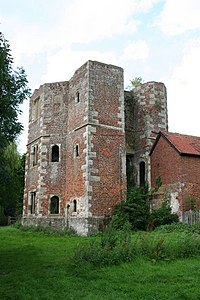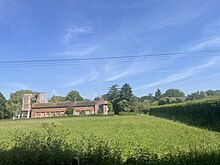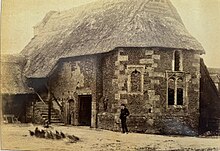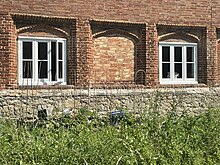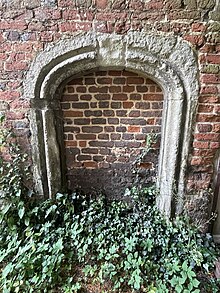
The archbishop of Canterbury is the senior bishop and a principal leader of the Church of England, the ceremonial head of the worldwide Anglican Communion and the bishop of the diocese of Canterbury. Justin Welby was enthroned as archbishop of Canterbury at Canterbury Cathedral on 21 March 2013. In late 2024, he announced his resignation, to take effect on 6 January 2025. Welby is the 105th person to hold the position, as part of a line of succession going back to Augustine of Canterbury, the "Apostle to the English", who was sent to England by Pope Gregory the Great and arrived in 597.

Canterbury Cathedral is the cathedral of the archbishop of Canterbury, the spiritual leader of the Church of England and symbolic leader of the worldwide Anglican Communion. Located in Canterbury, Kent, it is one of the oldest Christian structures in England and forms part of a World Heritage Site. Its formal title is the Cathedral and Metropolitical Church of Christ, Canterbury.

Addington Palace is an 18th-century mansion in Addington located within the London Borough of Croydon. It was built close to the site of an earlier manor house belonging to the Leigh family. It is particularly known for having been, between 1807 and 1897, the summer residence of the Archbishops of Canterbury. Since the 1930s most of the grounds have been occupied by Addington Palace Golf Club. Between 1953 and 1996 the mansion was occupied by the Royal School of Church Music, which has since moved to Salisbury. It was later used as a wedding and events venue.
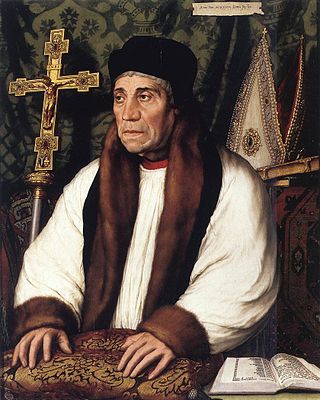
William Warham was the Archbishop of Canterbury from 1503 to his death in 1532.
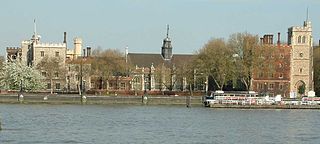
Lambeth Palace is the official London residence of the Archbishop of Canterbury. It is situated in north Lambeth, London, on the south bank of the River Thames, 400 yards south-east of the Palace of Westminster, which houses Parliament, on the opposite bank.

Sevenoaks is a town in Kent with a population of 29,506, situated south-east of London, England. Also classified as a civil parish, Sevenoaks is served by a commuter main line railway into London; the town is 21 miles (34 km) from Charing Cross, the traditional centre of London. It is the principal town of the Sevenoaks district, followed by Swanley and Edenbridge.
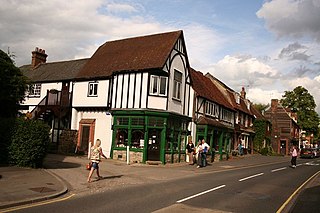
Otford is a village and civil parish in the Sevenoaks District of Kent, England. It lies on the River Darent, 3 miles (5 km) north of Sevenoaks. Otford's four churches are the Anglican Church of St Bartholomew in the village centre, the Otford Methodist Church, the Most Holy Trinity Roman Catholic Church, and the Otford Evangelical Church. By the village pond, there are pubs, cafes and shops. The village has three schools, Otford Primary School, St Michael's Prep School, and Russell House.

Knole is a British country house and former archbishop's palace owned by the National Trust. It is situated within Knole Park, a 1,000-acre (400-hectare) park located immediately to the south-east of Sevenoaks in west Kent. The house ranks in the top five of England's largest houses, under any measure used, occupying a total of 4 acres (1.6 ha).

The Darent is a Kentish tributary of the River Thames and takes the waters of the River Cray as a tributary in the tidal portion of the Darent near Crayford. 'Darenth' is frequently found as the spelling of the river's name in older books and maps, Bartholomew's Canals and River of England being one example. Bartholomew's Gazetteer (1954) demonstrates that Darent means "clear water", a result of it springing from and running through chalk. The purity of the water was a major factor in the development of paper and pharmaceuticals in the area.
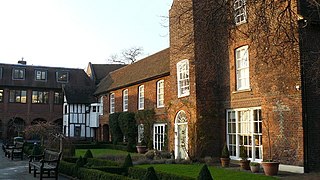
Croydon Palace, in the Old Town neighbourhood of Croydon, now part of south London, was the summer residence of the Archbishop of Canterbury for over 500 years. Regular visitors included Henry III and Queen Elizabeth I. Now known as Old Palace, the buildings are still in use as Old Palace School, an independent girls' school that is now part of the Whitgift Foundation. It has been a Grade I listed building since 1951.
Bekesbourne-with-Patrixbourne is a civil parish in the City of Canterbury district of Kent, England. It is located 4 miles south-east of Canterbury.
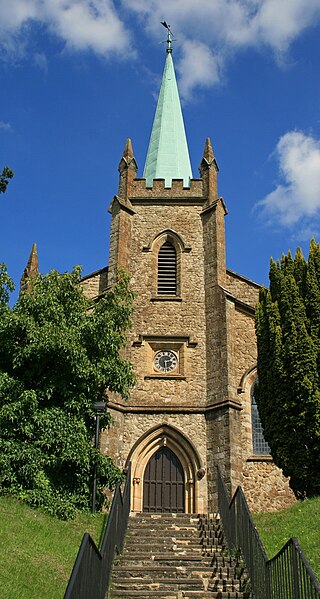
Riverhead is a northern village part of the urban area of Sevenoaks in the district of the same name in Kent, England and is also a civil parish. The parish had a population in 2001 of 1821, increasing to 2,634 at the 2011 Census.

Layer Marney Tower is an incomplete early Tudor country house, with gardens and parkland, dating from about 1523, in Layer Marney, Essex, England, between Colchester and Maldon. The building was designated Grade I listed in 1952.
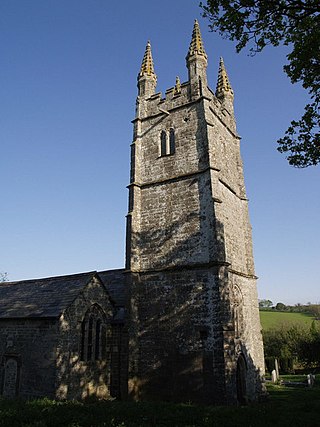
Bradstone is a village in Devon, England, on the River Tamar. It has a small church and a Tudor hall with an attractive gatehouse.
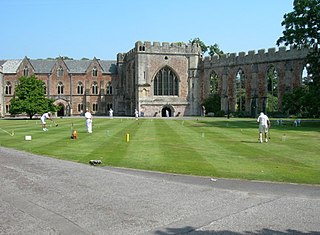
The Bishop's Palace is the residence of the bishop of Bath and Wells in Wells, Somerset, England. The palace is adjacent to Wells Cathedral and has been the residence of the bishops since the early thirteenth century. It has been designated a grade I listed building.

Pen y Bryn is a two-storey manor house, in Abergwyngregyn, Gwynedd, in north-west Wales, adjacent to the A55, five miles east of Bangor and eight miles west of Conwy. It is constructed mainly of broken stone, with roughly dressed quoins and a slate roof. The house is situated within Garth Celyn, a double bank and ditch, overlooking the Menai Strait to Anglesey. A smaller house was immediately adjacent in 1811 when Sir Richard Colt-Hoare recorded it; this was demolished by 1815. The present structure incorporates a four-storey stone tower. The present roof timbers were dated by dendrochronology to 1624, when the house was refurbished. There is evidence of long use with multiple rebuildings before 1624, but there is disagreement on the duration and nature of its mediaeval use.

The Archbishop's Palace is a Grade I listed historic 14th-century and 16th-century building on the east bank of the River Medway in Maidstone, Kent. Originally a home from home for travelling archbishops from Canterbury, the building has been most recently used as a venue for wedding services. The former tithe barn for the palace, now serves as the Tyrwhitt-Drake Museum of Carriages.

Knole Academy is a secondary school in Sevenoaks, Kent, England, with a grammar band and Sixth-Form. Knole opened in September 2010 as a result of the amalgamation of the Wildernesse secondary school in Sevenoaks, Kent and Bradbourne School As part of Knole Academy Trust, the organization transitioned to Aletheia Academies Trust in 2024.
Ford Palace was a residence of the Archbishops of Canterbury at Ford, about 6.6 miles (10.6 km) north-east of Canterbury and 2.6 miles (4.2 km) south-east of Herne Bay, in the parish of Hoath in the county of Kent in south-eastern England. The earliest structural evidence for the palace dates it to about 1300, and the earliest written references to it date to the 14th century. However, its site may have been in use for similar purposes since the Anglo-Saxon period, and it may have been the earliest such residence outside Canterbury.
